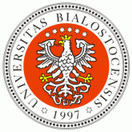Sponsors:





|
|
Organized by
the Institute of Experimental Physics, University of Bialystok
Wieslawa Sikora
AGH University of Science and Technology, Krakow, Poland
Symmetry Analysis in the Description of Phase Transition in Crystals
-
The symmetry analysis based on the theory of groups and representations has been successfully used for many years in the description of structural - displacement type phase transitions. In the description of magnetic ordering in crystals it was at first introduced by E.F. Bertaut [1, 2]. He obtained for the magnetic structure the symmetry-adapted ordering modes, derived from the representation analysis by calculation of the basis vectors of irreducible representations. That line of analysis has been later developed by many other theoreticians, like Izyumov [3] and others. In its present form the symmetry analysis is also developed on the case of structural - order-disorder type phase transitions and quadrupolar ordering. Also the coexistence of different type of phase transitions in given crystal may be discussed in the frame of this method. For symmetry analysis calculations few computer programs are elaborated and are allow in the WEB pages - one of them is the MODY program [4, 5, 6, 7].
In this lecture after the short introduction to the symmetry analysis the description of MODY program and the instruction how to use it will be presented. The examples of using the OUTPUT-s of MODY for calculation of new structure types allowed by initial phase symmetry, for all types of mentioned above phase transitions, will be done. The participants will have the possibility to use computers and to take active part in these calculations.
[1] G.T. Rado, H. Suhl, Treatise on Magnetism, vol. 3, Chapter 4 by E. F. Bertaut , Academic Press, New York, 1963,
[2] E.F. Bertaut, J. Phys., 32, C1 (1971) 462
[3] Yu.A. Izyumov, V.N. Syromyatnikov, Phase Transitions and Crystal Symmetry, Dordrecht: Kluwer Academic Publishers, 1990, Chapter 2.
[4] W.Sikora, F.Białas and L.Pytlik, J. Appl. Cryst. (2004). 37, 1015-1019
(http://novell.ftj.agh.edu.pl/~sikora/mody.html),
[5] Capillas C., Kroumova E., Aroyo, M.I., Perez-Mato, J.M., Stokes H.T.and Hatch D.M. J. Appl. Cryst., 36, (2003) 953-954 http://www.physics.byu.edu/~stokesh/isotropy.html
[6] Wills, A.S., (2000), Physica B, 276, 680, (program available from ftp://ftp.ill.fr/pub/dif/sarah
[7] Rodrigues-Carvajal, J, BasIreps, - program available from: http://www.ccp14.ac.uk/ccp/ccp14/ftp-mirror/fullprof/pub/divers/BasIreps/
|
|
|